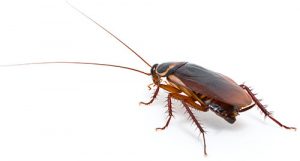Cockroach
 Cockroaches grow to 1/2-5/8 inches long when mature, are light brown to tan in color, and have fully developed wings. The shield-like segment located behind the head has two dark parallel bars on it.
Cockroaches grow to 1/2-5/8 inches long when mature, are light brown to tan in color, and have fully developed wings. The shield-like segment located behind the head has two dark parallel bars on it.
The nymphs are 1/8 inch long in size when they emerge from the egg capsule. They are almost uniformly dark with the exception of a light tan area on the back of the second and third segments. The rectangle shaped egg capsules are light brown colour and are 1/4-3/4 inches long. Typically, each egg capsule has 15 to 20 eggs per side.
Cockroaches have many negative consequences for human health because certain proteins (called allergens) found in cockroach feces, saliva and body parts can cause allergic reactions or trigger asthma symptoms, especially in children. Cockroaches can also passively transport microbes on their body surfaces including pathogens that are potentially dangerous to humans. Cockroaches have been implicated in the spread 33 kinds of bacteria, including E. coli and Salmonella species, six parasitic worms and more than seven other types of human pathogens.
While there are many types of cockroaches around the world, in Vancouver, BC we mainly see the following five: German, Oriental, American, Brown-banded, and Wood roach. The German cockroach is the most common of the five and is a very prolific breeder. While some people believe cockroaches are the result of unsanitary conditions, we regularly see cockroach infestations in the cleanest kitchens. They are very hard to prevent as they can be brought into a home in boxes or groceries bags. They seem to be able to find food in the most minute crack or crevice. Occasionally people bring cockroaches home from vacations in the southern U.S. or the Caribbean.
Cockroaches nest in cracks and crevices and they are attracted to food, water and shelter. Almost anything is food to cockroaches including plants, paper, cloth, and even glue used for binding books! They prefer a damp environment, and are mostly active at night.
Family
Blattodea/Blattellidae
Scientific Name
Blattella germanica
Biology
During her lifetime, the female cockroach produces four to eight egg capsules each containing 30 to 40 eggs. Approximately one to two days before hatching, she drops the egg capsule in a protected area. Nymphs moult six to seven times before becoming adults. This requires about 103 days; thus allowing three to four generations per year. Adults live 100 to 200 days.
Behaviour
Cockroaches typically infest kitchens and bathrooms but will live anywhere inside heated structures in which there is food, water, and harbourage. Cockroaches gain access to structures in grocery bags, cardboard boxes, infested equipment such as used refrigerators, toasters, microwaves, etc…
They are most active at night, leaving their harbourage areas to find food and water.
Control & Prevention
An effective cockroach program depends on good sanitation to eliminate the food, water and harbourage areas. The use of gel baits and dust are the most effect means of control. Glue traps are helpful but are usually used as monitoring devices rather than control measures. A thorough vacuuming of harbourage areas is also very helpful in reducing cockroach populations.
An inspection of articles entering your home is a good idea; particularly food items. Cockroaches are hard to prevent but good sanitation practices will limit the infestation of this insect.
To successfully eliminate your cockroach problem, a complete home inspection must be performed in order to determine the type and extent of the infestation. Nikol Pest Control experts will start by identifying their harborages, travel routes, and food and water sources, gathering the necessary information to create a specific plan of attack to manage and control the existing problems.
Need help with Cockroaches extermination?
Call Nikol Pest Control at 604-364-3201 for a free estimate.

